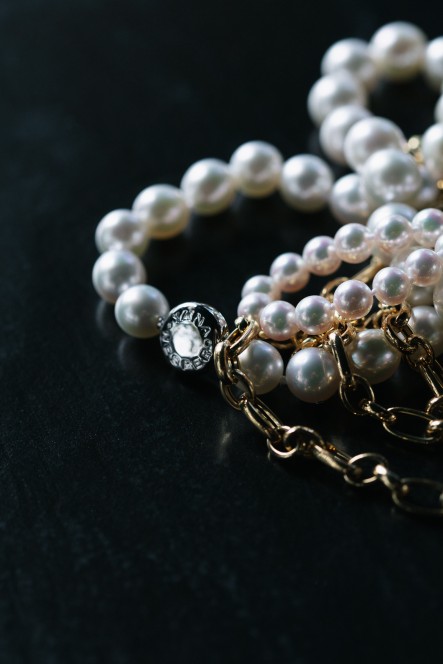Akoya pearls are considered the "birth pearl" of modern pearl culture. For more than 100 years, the fine white, silvery shimmering pearl has been cultivated in Japan and beyond its borders. Find out what you need to know about it and how it is perfect for fine pearl jewellery here.
The Akoya pearl marked the birth of modern pearl farming; where nature and water are still pristine and clean, Akoya cultured pearls mature in the solitary seclusion of an oyster. This oyster is called Pinctada Fucata Martensii, also known simply as the Akoya oyster.
With their almost perfect curves and particularly radiant lustre, Akoya pearls lend many of the YANA NESPER jewellery pieces their luxurious elegance. Only the most beautiful and precious of these saltwater pearls are processed into jewellery in the Pforzheim pearl jewellery manufactory.
Are Akoya pearls precious?
Akoya pearls belong to the group of salt water pearls. They are characterised in particular by their very solid, hard and finely crystallised mother-of-pearl. This natural characteristic produces the unsurpassable luster, the mysterious silky sheen. The Akoya pearl is also known for this luster: It is considered one of the most radiant pearls, which refracts the light many times in the surface and thus shimmers particularly strongly.
Compared to the Tahiti or South Sea pearl - other types of pearls from salt water - the Akoya oyster is relatively small. Therefore, it naturally produces somewhat smaller, but mostly round cultured pearls. They grow for between eight months and two years and can be fitted with up to five spherical nuclei (pearl nuclei) - on average two per oyster.
As a saltwater pearl that grows in complex cultivation, it is, like other pearls, extremely valuable. From the time the nacre is planted to the time it is harvested, no one knows whether a truly beautiful pearl will grow inside. And of those oysters that actually produce pearls, only a few of absolute top quality can be used as gemstones. Each Akoya pearl is therefore a precious unique specimen, and no two are alike.
What do Akoya pearls look like?
Characteristic of the Akoya pearl, as already mentioned, is its unique, intense luster: the colour of Akoya pearls is white with an iridescent hint of rosé, sometimes silver or even greenish.
The size of this popular type of pearl varies between 2 and 10 mm. This is relatively small for cultured pearls – e.g South Sea pearls can grow much bigger! However, this is due to the oyster, which is small to begin with, in which the Akoya pearl grows.
What is the symbolic meaning of Akoya pearls?
Like other pearls, the Akoya pearl primarily symbolises pure, natural elegance. As the only jewel that springs from a living being, it has a special magic. Its connection to the ocean also gives it depth and a special uniqueness.
Akoya pearls are also in great demand for bridal jewellery: the elegant pearl with its intense lustre is an ideal match for wedding gowns and the wonderful elegance of a bride. We have already reported on pearls and their importance for weddings in a previous blog article.
What makes Akoya pearls special?
In summary, these 5 features are probably what make Japanese Akoya pearls a very special type of pearl:
1. particularly intense luster
2. small because of the small oyster, but often almost perfectly round in shape
3. cool white, silvery to rosé shimmering colour
4. extremely elegant and popular for bridal jewellery
5. considered the "birth pearl" of modern pearl farming






















